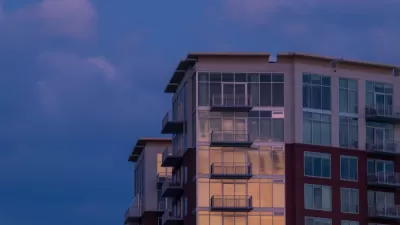A suite of zoning changes that would increase building heights and density along the Passaic River in Newark, New Jersey, provoked a chaotic council hearing that devolved into shouting and the removal of residents from the council chambers.

Karen Yi reports from Newark, New Jersey, where "[c]haos erupted at the Newark City Council meeting Wednesday night as residents' fury over housing opportunities escalated into heated exchanges between the public and city employees."
"Throughout the night, residents vented their frustrations with the lack of low-income housing in the city and decried plans to allow buildings near the city's riverfront to tower as high as 40 stories and others in the Ironbound section to reach 12 stories," according to Yi.
At the core of the controversy are two proposed land use regulation changes. One would create a high density residential and commercial zone, thus increasing height limits, in the Ironbound District. The second would "amend the redevelopment plan for the riverfront and allow buildings to increase their maximum heights from 10 to 25 stories in one area and from 30 to 40 stories in another," according to Yi.
Yi reports that the city has deferred the Ironbound District zoning changes, and will consider the amendments to the "Newark's River: Public Access and Redevelopment Plan" for final adoption at its October 4 hearing.
As for the chaos that erupted during the meeting, Yi posted a video of several residents being escorted from the meeting while trading heated exchanges with city employees.
FULL STORY: WATCH: Anger, chaos erupt at Newark council meeting over housing

Study: Maui’s Plan to Convert Vacation Rentals to Long-Term Housing Could Cause Nearly $1 Billion Economic Loss
The plan would reduce visitor accommodation by 25,% resulting in 1,900 jobs lost.

North Texas Transit Leaders Tout Benefits of TOD for Growing Region
At a summit focused on transit-oriented development, policymakers discussed how North Texas’ expanded light rail system can serve as a tool for economic growth.

Why Should We Subsidize Public Transportation?
Many public transit agencies face financial stress due to rising costs, declining fare revenue, and declining subsidies. Transit advocates must provide a strong business case for increasing public transit funding.

How to Make US Trains Faster
Changes to boarding platforms and a switch to electric trains could improve U.S. passenger rail service without the added cost of high-speed rail.

Columbia’s Revitalized ‘Loop’ Is a Hub for Local Entrepreneurs
A focus on small businesses is helping a commercial corridor in Columbia, Missouri thrive.

Invasive Insect Threatens Minnesota’s Ash Forests
The Emerald Ash Borer is a rapidly spreading invasive pest threatening Minnesota’s ash trees, and homeowners are encouraged to plant diverse replacement species, avoid moving ash firewood, and monitor for signs of infestation.
Urban Design for Planners 1: Software Tools
This six-course series explores essential urban design concepts using open source software and equips planners with the tools they need to participate fully in the urban design process.
Planning for Universal Design
Learn the tools for implementing Universal Design in planning regulations.
City of Santa Clarita
Ascent Environmental
Institute for Housing and Urban Development Studies (IHS)
City of Grandview
Harvard GSD Executive Education
Toledo-Lucas County Plan Commissions
Salt Lake City
NYU Wagner Graduate School of Public Service





























